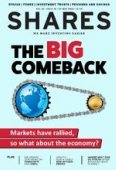Archived article
Please note that tax, investment, pension and ISA rules can change and the information and any views contained in this article may now be inaccurate.
Everything you need to know about picking ETFs

Exchange-traded funds (ETFs) are a good starting point for investors looking to gain low-cost exposure to a broad range of financial markets.
They enable you to track various groups of companies, bonds or commodities from around the world. Ultimately ETFs can provide the building blocks of a diversified portfolio.
ETFs can be much cheaper than a traditional investment fund that uses a fund manager to pick the holdings. ETFs simply follow an index; the companies, bonds or commodities that go into each index are chosen based on specific rules. For example, a FTSE 100 index would track the 100 largest companies by value on the London Stock Exchange.
ETFs are known as passive investment vehicles. The typically lower fee is really important because charges for an investment can make a material difference to long-term returns.
A key point to consider is that an ETF will only track the market rather than outperform or underperform, which is what you might see with an actively-managed fund.
WHAT ARE ETFS?
Like a fund, ETFs diversify an investor’s money across a range of underlying holdings thus spreading the risk. But in addition they are traded on the stock market, meaning they can be traded online at a live market price throughout the day, just like regular shares.
The sheer breadth of options available can be overwhelming and some of the key points of comparison that investors typically use, such as index composition, fees, replication method and whether the fund is accumulating or distributing, may seem tricky to navigate at first. However, it shouldn’t take long to understand how it all works.
What's the difference between physical and synthetic replication?
These terms refer to the method by which an exchange-traded fund achieves its tracking of a market.
Physically-backed products trade directly in the underlying stocks and shares in an index to replicate the performance of a market, while synthetic ETFs employ a swap-based method of replication.
The latter can be a bit complicated to understand but fortunately most ETFs just use physical replication.
RANGE OF OPTIONS
Some ETFs track a basket of investments based on certain criteria such as income from dividends. Others might focus on a theme such as robotics companies or a sector like healthcare.
However, the most popular ETFs are more straightforward products which are simply seeking to replicate as closely
as possible the performance of an stock index like the UK’s
FTSE 100 or S&P 500 in the US.
Examples of ETFs
Investors seeking exposure to the UK stock market have lots of choice including iShares Core FTSE 100 (ISF) which has an ongoing charge of 0.07% and tracks the 100 largest London-listed stocks.
An example of an ETF providing global exposure to equities is HSBC MSCI World (HMWD); it tracks a basket of companies in 23 developed markets for an OCF of 0.15%.
For gold exposure WisdomTree Physical Swiss Gold (SGBX), backed by actual gold bullion, is among the cheapest options with a 0.19% charge.
Other ETFs include Invesco GBP Corporate Bond ETF (IGCB) which invests in bonds issued by big companies such as banks and utility providers.
Lyxor Core MSCI Japan ETF (LCJP) is a good example of an ETF which tracks the performance of large and medium-sized companies on the Japanese stock market.
For those seeking exposure to bricks and mortar, a relevant product is iShares UK Property ETF (IUKP) which tracks a basket of real estate companies.
UNDERSTANDING COSTS
It is also worth looking at how consistently a product has tracked its benchmark. As a rule of thumb – and assuming otherwise perfect tracking – an ETF should underperform its benchmark by an amount equal to its ongoing charges figure (OCF) on an annual basis.
The OCF gives a guide to how much of your investment is taken up by costs – an OCF of 0.3%, for example, would mean that for every £100 you invest, 30p is lost to costs.
Most ETFs are exempt from the stamp duty you pay when trading shares.
As with other listed entities you should look at the bid/offer spread, which is the difference between the price you pay to buy an ETF and the price you would get for selling it.
Another thing to consider is the amount of assets in an ETF – the higher the level, the less likely it is to close due to lack of interest and the more likely it is to be easily traded and low cost. A good rule of thumb is to look for ETFs with more than £100m in assets.
HOW ETFS ARE RATED
Financial information providers Morningstar and Trustnet both provide rating services for ETFs which are available for free on their websites. These can be good places to start your research.
For the Trustnet service, ETFs will be awarded between one and five ‘Passive Crowns’, based on their ability to track their index over a three-year period. The Morningstar rating offers a measure of on ETF’s performance versus its peer group and is based on a 1 to 5-star rating.
More information on ETFs
Further details on ETFs can be found in these useful articles:
Build a portfolio with just three ETFs
Important information:
These articles are provided by Shares magazine which is published by AJ Bell Media, a part of AJ Bell. Shares is not written by AJ Bell.
Shares is provided for your general information and use and is not a personal recommendation to invest. It is not intended to be relied upon by you in making or not making any investment decisions. The investments referred to in these articles will not be suitable for all investors. If in doubt please seek appropriate independent financial advice.
Investors acting on the information in these articles do so at their own risk and AJ Bell Media and its staff do not accept liability for losses suffered by investors as a result of their investment decisions.
Issue contents
Editor's View
Feature
First-time Investor
Great Ideas
Money Matters
News
- Exit charge lowered on Lifetime ISA as a temporary measure
- Companies will need to start quantifying Covid-19 impact
- Investors need to be prepared for terrible second quarter results
- Why these stocks have just hit all-time highs
- Orbis seeing ‘most exceptional discounts’ since the credit crunch
- Could we see a return of M&A due to the crisis?
- Berkshire Hathaway builds cash to record levels, sell airline stocks

 magazine
magazine










